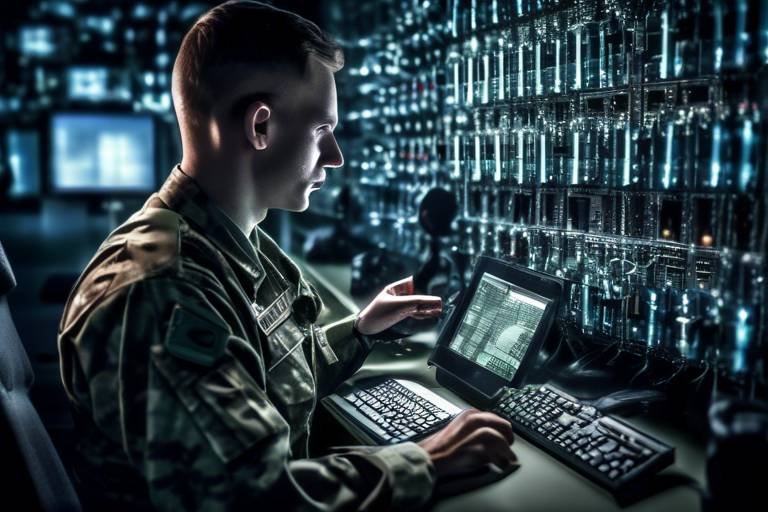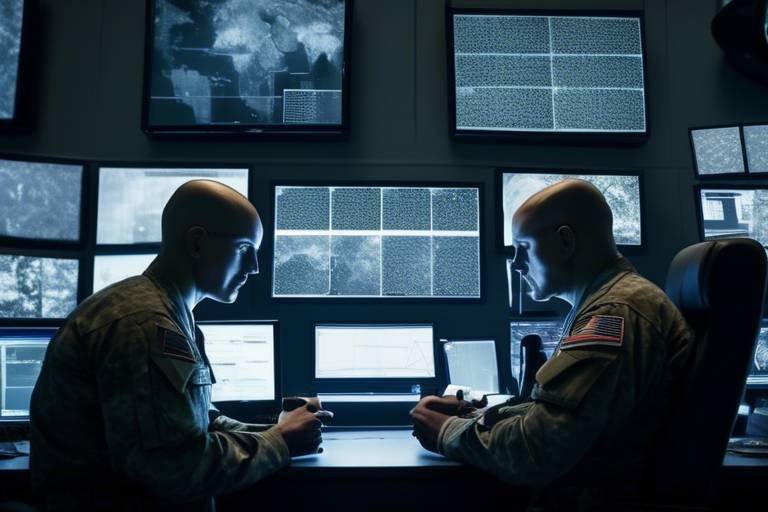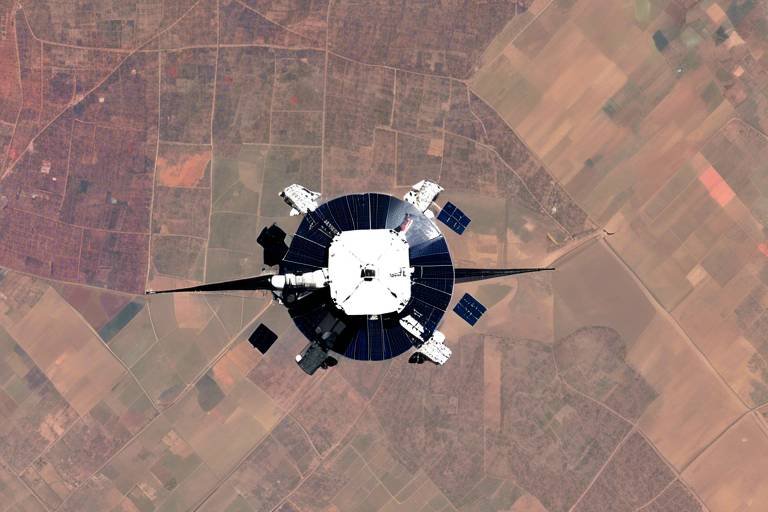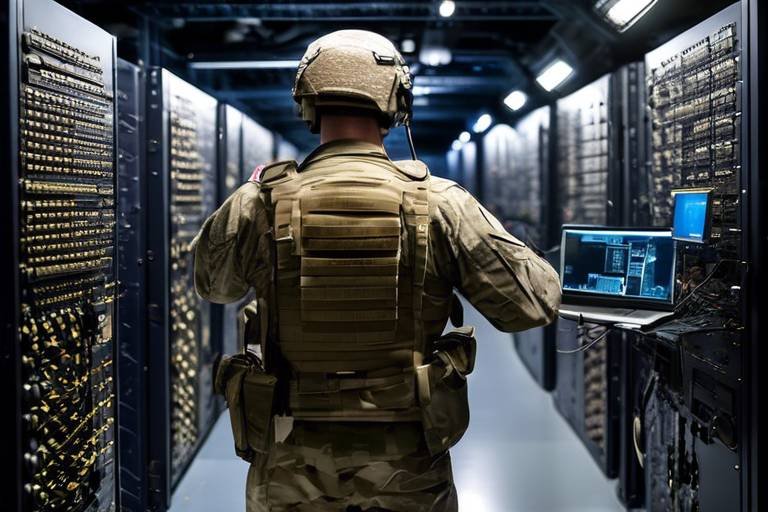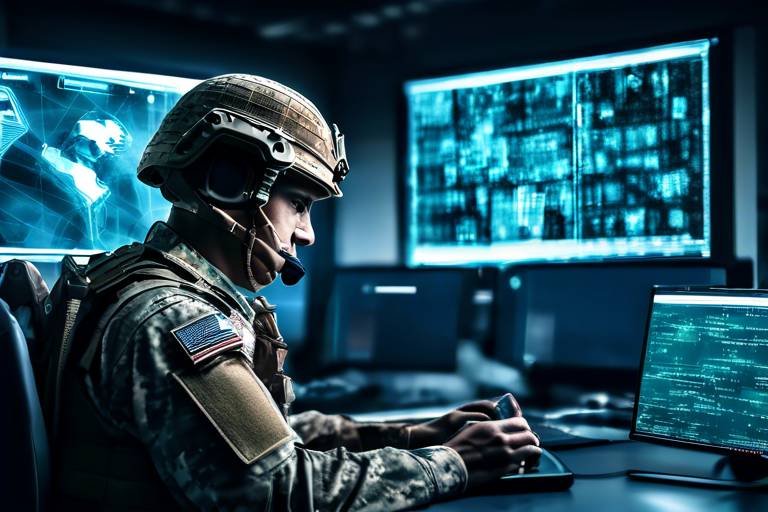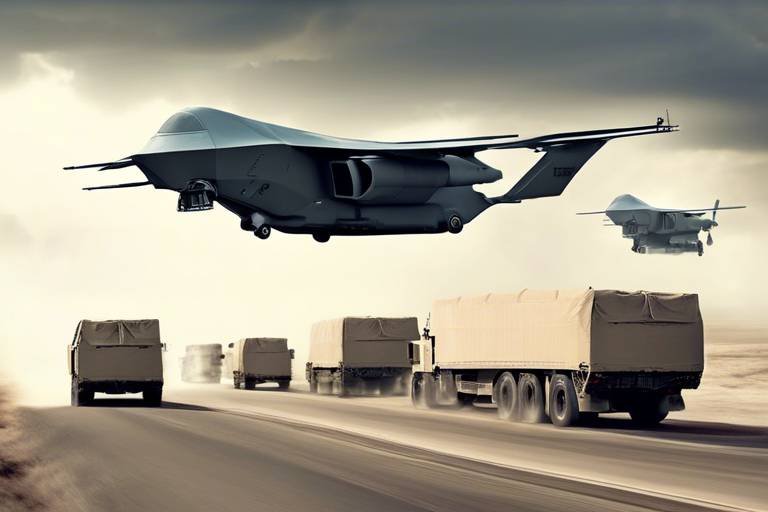Quantum Key Distribution in Military Communications
In today's world, where information is power, the need for secure military communications has never been more critical. With the rise of sophisticated cyber threats and the ever-evolving landscape of warfare, traditional encryption methods are becoming increasingly vulnerable. Enter Quantum Key Distribution (QKD), a groundbreaking technology that promises to revolutionize how military organizations secure their communications. By leveraging the principles of quantum mechanics, QKD not only enhances the confidentiality of sensitive information but also provides a robust defense against potential breaches. Imagine a world where military secrets are transmitted with absolute certainty, where eavesdropping is rendered futile. This is the promise of QKD, and in this article, we will explore its significance, mechanisms, applications, and the challenges it faces in modern defense systems.
At its core, Quantum Key Distribution is a method that utilizes the strange and fascinating principles of quantum mechanics to securely distribute encryption keys. Unlike conventional methods, which often rely on mathematical algorithms that can be cracked with enough computational power, QKD employs the properties of quantum particles to ensure that any attempt at eavesdropping will be immediately detectable. Think of it as sending a secret message in a bottle that, if tampered with, will shatter and reveal the breach. This section delves into the underlying principles of QKD, explaining how it guarantees the confidentiality of military communications and keeps adversaries at bay.
When it comes to military communications, security is not just a priority; it's a necessity. The stakes are incredibly high, and the information being transmitted can determine the outcome of missions, the safety of personnel, and even national security. As threats evolve—from sophisticated cyberattacks to traditional espionage—the need for advanced encryption methods like QKD becomes increasingly apparent. Military organizations must stay one step ahead, ensuring that sensitive information remains confidential and protected from prying eyes. In this section, we'll discuss the various threats faced in military environments and how QKD offers a cutting-edge solution.
The landscape of military communications is fraught with challenges. Various threats, including cyberattacks, insider threats, and physical security breaches, can compromise the integrity of communication systems. These threats can have dire implications for national security, potentially jeopardizing missions and endangering lives. Understanding the types of threats faced is crucial for developing effective countermeasures. Below are some common threats:
- Cyberattacks: Sophisticated hackers can infiltrate military networks, stealing sensitive data or disrupting communications.
- Espionage: State-sponsored actors may engage in spying to gather intelligence on military operations.
- Insider Threats: Individuals within the military can pose risks by leaking information or sabotaging systems.
As technology advances, so do the tactics employed by cyber adversaries. Military communications face specific cybersecurity challenges, including the need for real-time data transmission, the protection of legacy systems, and the integration of new technologies. QKD plays a pivotal role in mitigating these risks, providing a secure method for exchanging encryption keys that is resistant to even the most sophisticated attacks. By utilizing QKD, military organizations can ensure that their communications remain confidential and secure.
Insider threats are particularly insidious, as they can compromise military communications from within. These threats can arise from disgruntled employees, unintentional negligence, or even coercion by external actors. QKD can help protect against unauthorized access by ensuring that any attempt to intercept or tamper with key distribution is immediately detected. This capability not only maintains the integrity of sensitive information but also fosters a culture of trust within military organizations.
So, how does Quantum Key Distribution actually work? At its essence, QKD utilizes the principles of quantum mechanics to create secure communication channels. By encoding encryption keys in quantum particles, QKD ensures that any attempt at eavesdropping will disrupt the quantum state, alerting the communicating parties to the breach. This section breaks down the technical aspects of QKD, explaining how it is implemented in military settings and the benefits it offers over traditional encryption methods.
The applications of QKD in military communications are vast and varied, enhancing secure data transmission across different platforms. From battlefield communications to secure command and control systems, QKD is being integrated into defense operations in innovative ways. This section highlights real-world examples of how QKD is being utilized to strengthen military communications.
Several military organizations around the globe are currently deploying QKD in the field. These case studies showcase successful implementations of QKD technology and the resulting benefits, such as improved security and resilience against cyber threats. As more military units recognize the advantages of QKD, we can expect to see its adoption become more widespread.
The future of Quantum Key Distribution in military communications looks incredibly promising. With ongoing research and development, we can anticipate advancements that will further enhance the security and efficiency of military communications. As national defense strategies evolve, so too will the role of QKD in safeguarding sensitive information and ensuring operational success.
Q: What is Quantum Key Distribution?
A: Quantum Key Distribution (QKD) is a method of securely distributing encryption keys using the principles of quantum mechanics, ensuring that any eavesdropping attempts are detectable.
Q: How does QKD improve military communications?
A: QKD enhances military communications by providing a secure method for key exchange, making it extremely difficult for adversaries to intercept or tamper with sensitive information.
Q: What are the main threats to military communications?
A: The main threats include cyberattacks, espionage, and insider threats, all of which can compromise the integrity and confidentiality of military communications.
Q: Are there real-world examples of QKD being used in the military?
A: Yes, several military organizations have successfully deployed QKD in the field, showcasing its effectiveness in enhancing secure data transmission.
Q: What does the future hold for QKD in military applications?
A: The future of QKD in military communications is bright, with ongoing research and development likely to lead to more advanced implementations and broader adoption across defense strategies.

Understanding Quantum Key Distribution
Quantum Key Distribution, or QKD, is a revolutionary approach to secure communication that leverages the principles of quantum mechanics. At its core, QKD allows two parties to generate a shared, secret random key, which can then be used for encrypting and decrypting messages. The beauty of QKD lies in its ability to detect eavesdropping attempts, ensuring that any interception of the key can be identified and addressed immediately. This means that military communications, which often contain sensitive information, can be safeguarded against unauthorized access in ways that traditional encryption methods simply cannot match.
To understand how QKD works, we need to dive into a few fundamental concepts of quantum mechanics. One of the key principles is the concept of quantum superposition, which allows quantum bits, or qubits, to exist in multiple states simultaneously. When a qubit is measured, it 'collapses' into one of these states, and this process is inherently random. This randomness is what makes QKD so secure; if an eavesdropper tries to intercept the qubits, the act of measurement will disturb their state, alerting the communicating parties to the presence of a potential breach.
Additionally, QKD relies on the no-cloning theorem, which states that it is impossible to create an identical copy of an arbitrary unknown quantum state. This characteristic ensures that even if an adversary manages to intercept the quantum key, they cannot replicate it without detection. As a result, QKD provides a level of security that is fundamentally different from classical methods, which can be compromised if an attacker gains access to the encryption key.
In practical applications, QKD involves the use of various protocols, such as the BB84 protocol, developed by Charles Bennett and Gilles Brassard in 1984. This protocol uses the polarization states of photons to encode the key information. The sender (Alice) transmits a series of photons to the receiver (Bob), who measures them using randomly chosen bases. After the transmission, Alice and Bob compare their results over a classical channel to identify which bits were successfully transmitted and to detect any eavesdropping attempts.
The integration of QKD into military communications can significantly enhance security measures. However, implementing this technology is not without its challenges. The need for specialized equipment, the complexity of quantum systems, and the requirement for a secure classical channel to exchange information about the key are just a few hurdles that need to be addressed. Nevertheless, the potential benefits—such as ensuring the integrity and confidentiality of sensitive military operations—make QKD a promising avenue for future defense strategies.
In summary, Quantum Key Distribution represents a paradigm shift in secure communications, especially for military applications. By harnessing the principles of quantum mechanics, QKD not only provides robust security but also offers a proactive approach to detecting and mitigating threats. As we continue to explore the frontiers of quantum technology, the implications for military communications could be profound, paving the way for a new era of secure information exchange.
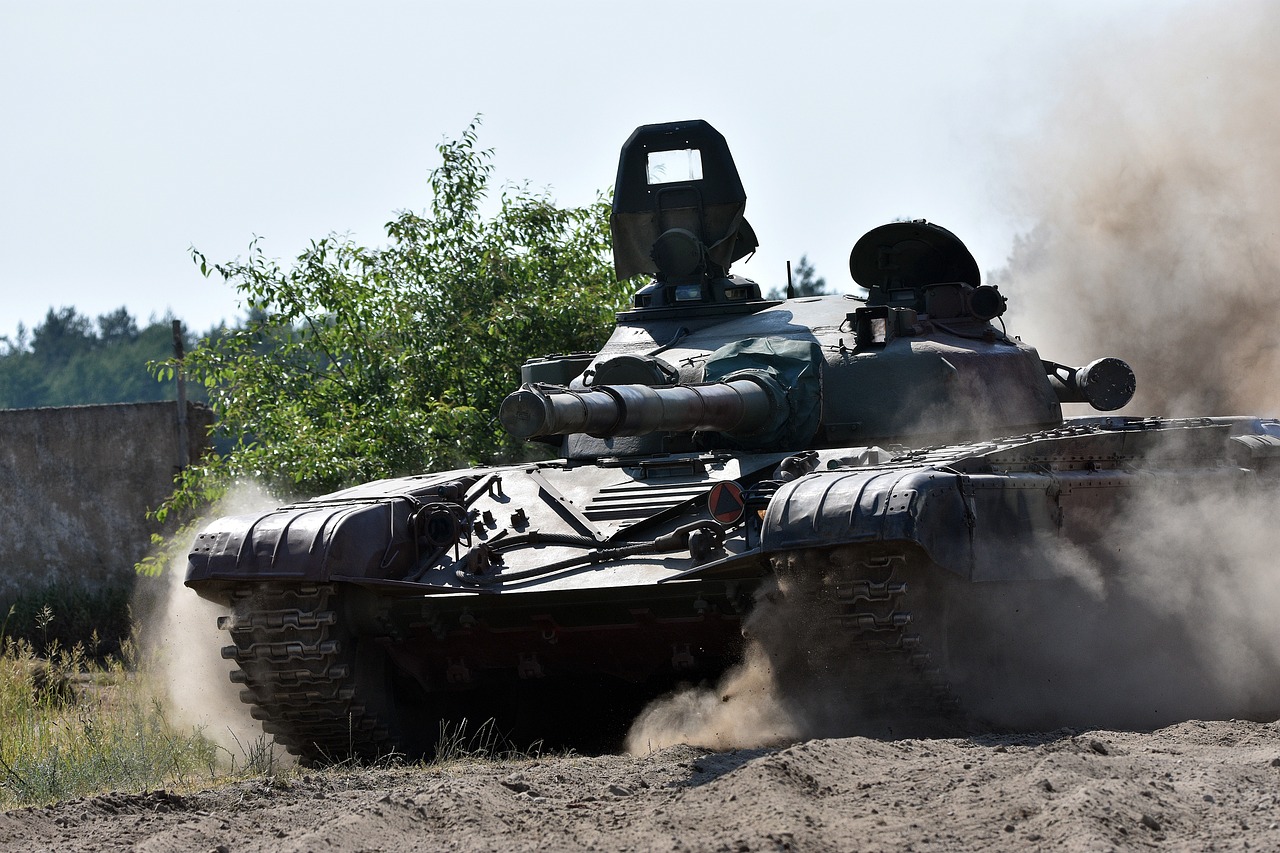
Importance of Security in Military Communications
In today's rapidly evolving world, the importance of security in military communications cannot be overstated. With the increasing reliance on digital technologies and interconnected systems, military forces are confronted with a myriad of threats that could compromise sensitive information. The stakes are incredibly high; a single breach can lead to catastrophic consequences, not just for military operations but for national security as a whole. This is where advanced encryption methods, such as Quantum Key Distribution (QKD), come into play, offering a robust solution to protect critical communications.
The military operates in environments where information security is paramount. From strategic planning to real-time battlefield communications, the integrity of data is vital. Evolving threats, such as cyberattacks and espionage, demand that military communications systems employ the most sophisticated security protocols available. It’s not just about keeping secrets; it’s about ensuring that the right information reaches the right people at the right time, without interception or manipulation.
Consider the implications of a successful cyberattack on military communications. Imagine a scenario where enemy forces intercept communications detailing troop movements or strategic plans. The potential for misinformation and chaos could undermine entire operations. As such, military communications must not only be secure but also resilient against a variety of threats. This brings us to the need for advanced encryption methods like QKD, which leverages the principles of quantum mechanics to create secure channels for data transmission.
Moreover, the landscape of military threats is constantly changing. Traditional adversaries are now joined by sophisticated cybercriminals and state-sponsored hackers, all equipped with advanced tools and tactics. For instance, the rise of insider threats—where individuals within the organization pose risks—adds another layer of complexity to military security. QKD offers a promising solution to these challenges by ensuring that even if data is intercepted, it cannot be deciphered without the proper quantum keys.
In conclusion, the importance of security in military communications cannot be underestimated. As threats evolve, so too must the methods used to protect sensitive information. Quantum Key Distribution presents a cutting-edge solution that not only enhances security but also ensures that military operations can continue without the looming fear of compromised communications. The integration of QKD into military systems is not just a technological upgrade; it is a necessary evolution in the face of modern threats.
- What is Quantum Key Distribution?
Quantum Key Distribution is a method that uses quantum mechanics to securely distribute encryption keys, ensuring that any interception of the keys is detectable. - Why is security crucial in military communications?
Military communications contain sensitive information that, if compromised, could lead to significant operational and national security risks. - How does QKD protect against insider threats?
QKD ensures that only authorized personnel can access secure communications, making it difficult for insiders to compromise information without detection. - What are the future prospects of QKD in military use?
With ongoing research and advancements in quantum technology, the future of QKD in military communications looks promising, potentially revolutionizing how sensitive information is secured.

Threats to Military Communication Systems
In today's rapidly evolving technological landscape, military communication systems face a myriad of threats that can jeopardize national security. These threats are not just limited to external adversaries; they also come from within, manifesting in various forms. The complexity of modern warfare demands that military communications remain secure, resilient, and reliable. But what exactly are these threats, and how do they impact operations?
One of the most significant threats to military communication systems is the risk of cyberattacks. With the increasing reliance on digital infrastructure, adversaries are constantly developing sophisticated methods to infiltrate and disrupt communication networks. Cyberattacks can take many forms, including:
- Phishing Attacks: Deceptive emails and messages designed to trick personnel into revealing sensitive information.
- Denial-of-Service (DoS) Attacks: Overwhelming a system with traffic to render it unusable, thus crippling communication capabilities.
- Malware Infiltration: Malicious software that can compromise systems, steal data, or disrupt operations.
Moreover, the threat of espionage cannot be overlooked. State and non-state actors alike are increasingly using advanced techniques to gather intelligence on military operations. This includes the interception of communications, which can provide adversaries with valuable insights into tactics, strategies, and troop movements. The implications of such breaches are profound, potentially leading to operational failures and loss of life.
Adding another layer of complexity is the issue of insider threats. These threats arise from individuals within the military who may have access to sensitive information and systems. Whether motivated by financial gain, ideological beliefs, or coercion, insiders can pose a significant risk. They might leak classified information or intentionally sabotage communication networks, leading to catastrophic consequences. Protecting against these threats requires not only advanced technology but also a culture of vigilance and integrity within military organizations.
In summary, the threats to military communication systems are diverse and evolving. From cyberattacks and espionage to insider threats, the landscape is fraught with challenges that require robust security measures. As military operations become more complex and interconnected, the need for secure communication channels becomes ever more critical. The integration of advanced technologies like Quantum Key Distribution (QKD) offers a promising solution to enhance the security of military communications and mitigate these threats effectively.
Q1: What is the primary threat to military communication systems?
A1: The primary threats include cyberattacks, espionage, and insider threats, each posing unique risks to communication security.
Q2: How do cyberattacks impact military communications?
A2: Cyberattacks can disrupt communication networks, steal sensitive information, and compromise operational effectiveness.
Q3: What role does insider threat play in military communications?
A3: Insider threats can lead to unauthorized access to sensitive information, potentially resulting in severe operational consequences.
Q4: How can Quantum Key Distribution help mitigate these threats?
A4: Quantum Key Distribution provides a secure method for sharing encryption keys, making it significantly harder for adversaries to intercept and decrypt communications.

Cybersecurity Challenges
In today's digital battlefield, the stakes have never been higher. Military communications are under constant threat from a myriad of that can jeopardize national security. With the rapid evolution of technology, adversaries are becoming increasingly sophisticated, employing advanced tactics to infiltrate and disrupt military networks. These challenges are not just technical hurdles; they represent a significant risk to the confidentiality, integrity, and availability of crucial military information.
One of the most pressing cybersecurity challenges faced by military communications is the rise of state-sponsored cyberattacks. These attacks are often well-funded and meticulously planned, targeting specific vulnerabilities within military systems. The implications of such breaches can be catastrophic, leading to the exposure of sensitive data or even the disruption of critical operations. For instance, consider a scenario where an enemy gains access to a military command center's communication system. The potential for chaos is immense, as they could manipulate information or mislead decision-makers.
Additionally, the proliferation of Internet of Things (IoT) devices in military operations has introduced new vulnerabilities. While these devices can enhance operational efficiency, they also create multiple entry points for cyber adversaries. Each connected device is a potential gateway for hackers, making it essential for military organizations to implement stringent security measures across all devices.
Moreover, the challenge of keeping up with rapid technological advancements cannot be overstated. As military technologies evolve, so do the tactics employed by cybercriminals. This creates a perpetual game of cat and mouse, where military organizations must continuously adapt their defenses. Traditional cybersecurity measures often fall short against novel threats, necessitating the incorporation of advanced solutions like Quantum Key Distribution (QKD) to bolster security.
In light of these challenges, military organizations must prioritize the integration of innovative security protocols. Quantum Key Distribution, for instance, offers a promising solution by leveraging the principles of quantum mechanics to create secure communication channels. By utilizing QKD, military communications can achieve a level of security that is resistant to even the most advanced cyber threats.
To summarize, the cybersecurity challenges faced by military communications are multifaceted and evolving. From state-sponsored attacks to the vulnerabilities introduced by IoT devices, the landscape is fraught with risks. However, by embracing advanced technologies like QKD, military organizations can enhance their resilience against these threats and safeguard sensitive information.
- What is Quantum Key Distribution (QKD)?
QKD is a secure communication method that uses quantum mechanics to distribute encryption keys, ensuring that any interception attempts can be detected.
- Why is cybersecurity important in military communications?
Military communications often involve sensitive information that, if compromised, can have severe implications for national security and operational effectiveness.
- What are the main cybersecurity challenges faced by military communications?
Challenges include state-sponsored cyberattacks, vulnerabilities from IoT devices, and the need to keep pace with rapidly evolving technology.
- How does QKD help in mitigating cybersecurity risks?
QKD enhances security by ensuring that encryption keys are shared securely, making it extremely difficult for unauthorized parties to access or manipulate communication.

Insider Threats
Insider threats represent a unique and particularly insidious challenge in the realm of military communications. Unlike external adversaries who operate from a distance, insiders are individuals within the organization—be they employees, contractors, or even trusted partners—who have legitimate access to sensitive information and systems. This access can be exploited, either intentionally or unintentionally, leading to significant risks for national security. Imagine a trusted soldier, who has access to critical communications, suddenly deciding to share sensitive information with foreign entities. This scenario is not just a plot from a spy novel; it’s a real and pressing concern for military operations today.
To further understand the gravity of insider threats, consider the following key aspects:
- Types of Insider Threats: These can range from malicious insiders, who may act out of personal gain or ideological beliefs, to negligent insiders, who may inadvertently compromise security through careless actions.
- Potential Consequences: The ramifications of insider threats can be catastrophic, leading to the loss of sensitive data, operational disruptions, and even endangering lives in combat situations.
- Detection Challenges: Identifying insider threats is notoriously difficult because these individuals often have the necessary access and knowledge to evade detection.
In light of these challenges, Quantum Key Distribution (QKD) emerges as a powerful tool in mitigating the risks posed by insider threats. By utilizing the principles of quantum mechanics, QKD ensures that any attempt to intercept or tamper with the communication keys can be detected immediately. This means that even if an insider attempts to access sensitive communications, the integrity of the data can be maintained, and any unauthorized access can be flagged in real-time.
Moreover, QKD can be integrated into existing military communication systems to provide an additional layer of security. For instance, if a soldier attempts to share classified information over a QKD-enabled channel, any anomalies in the key distribution process can trigger alerts, allowing security personnel to intervene before any data is compromised. This proactive approach is akin to having a security guard who not only monitors the entrance but also has the ability to prevent unauthorized access before it occurs.
In conclusion, while insider threats present a daunting challenge to military communications, the implementation of QKD offers a promising solution. By enhancing the security of communication channels, QKD not only protects against external threats but also fortifies defenses against those who might exploit their trusted positions from within.
- What are insider threats? Insider threats are risks posed by individuals within an organization who have legitimate access to sensitive information and may exploit that access for malicious purposes.
- How does QKD help mitigate insider threats? QKD allows for secure key distribution, which can detect any unauthorized access attempts, ensuring the integrity of sensitive communications.
- Are insider threats always malicious? No, insider threats can be malicious or negligent. Negligent insiders may unintentionally compromise security through careless actions.
- Can QKD be integrated into existing military systems? Yes, QKD can be integrated into current communication systems to enhance security against both insider and external threats.

How Quantum Key Distribution Works
Quantum Key Distribution (QKD) is a groundbreaking method that leverages the principles of quantum mechanics to ensure secure communication. At its core, QKD allows two parties to generate a shared, secret random key that can be used for encrypting and decrypting messages. But how does it actually work? Let’s dive into the mechanics!
To understand QKD, it’s essential to grasp the concept of quantum bits or qubits. Unlike classical bits, which can be either 0 or 1, qubits can exist in a state of superposition, meaning they can represent both 0 and 1 simultaneously. This property is the foundation of QKD, allowing for the creation of keys that are fundamentally secure.
One of the most popular protocols for QKD is the BB84 protocol, developed by Charles Bennett and Gilles Brassard in 1984. This protocol involves the transmission of qubits between two parties, commonly referred to as Alice and Bob. Here’s a simplified breakdown of how it works:
- Preparation: Alice prepares a series of qubits in randomly chosen states. Each qubit can be polarized in one of four ways: horizontal, vertical, diagonal, or anti-diagonal.
- Transmission: Alice sends these qubits to Bob over a quantum channel.
- Measurement: Bob measures the qubits using randomly chosen bases. Afterward, he communicates with Alice to compare the bases used for measurement.
- Key Generation: They discard the qubits where their bases don’t match, and the remaining qubits form the shared secret key. Any eavesdropping attempts would disturb the qubits, alerting Alice and Bob to potential security breaches.
This process ensures that even if an adversary, often referred to as Eve, tries to intercept the qubits, any attempt to measure or clone them will introduce detectable anomalies. This unique property of quantum mechanics makes QKD a robust method for secure key exchange.
In military applications, the implementation of QKD can significantly enhance communication security. For instance, military networks can utilize QKD to protect sensitive data transmitted between command centers and operational units. By integrating QKD with existing encryption protocols, military communications can achieve a higher level of security, making it exceedingly difficult for adversaries to access classified information.
However, deploying QKD in real-world military environments presents challenges. The technology requires specialized equipment and infrastructure, including quantum repeaters to extend the range of quantum signals. Additionally, the integration of QKD into existing systems must be seamless to avoid operational disruptions. Despite these challenges, ongoing research and technological advancements are paving the way for broader adoption of QKD in military communications.
- What is Quantum Key Distribution? QKD is a secure communication method that uses quantum mechanics to distribute encryption keys between two parties.
- How does QKD ensure security? QKD leverages the principles of quantum mechanics, where any attempt to eavesdrop on the communication alters the quantum state, alerting the communicating parties.
- What are the applications of QKD in the military? QKD can be used to secure sensitive communications, protect data transmissions, and enhance overall cybersecurity measures in military operations.
- Are there challenges in implementing QKD? Yes, challenges include the need for specialized infrastructure, integration with existing systems, and the requirement for quantum repeaters for long-distance communication.

Applications of QKD in Defense
Quantum Key Distribution (QKD) is not just a theoretical concept; it is actively reshaping military communications by providing a robust framework for secure data transmission. In a world where cyber threats are becoming increasingly sophisticated, the integration of QKD into defense systems offers a promising solution to safeguard sensitive information. Imagine a world where every message sent between military units is encrypted with keys that are practically unbreakable—this is the reality that QKD aims to achieve.
One of the most compelling applications of QKD in defense is its ability to secure communication channels in real-time operations. For instance, during military missions, soldiers rely on constant communication to coordinate their actions and ensure mission success. By utilizing QKD, they can exchange encryption keys that are generated based on the principles of quantum mechanics, ensuring that any attempt to intercept the keys would be immediately detectable. This level of security is crucial for maintaining operational integrity and protecting classified information.
Moreover, QKD can be employed in various military applications, such as:
- Satellite Communications: QKD can enhance the security of data transmitted via military satellites, which are often vulnerable to interception.
- Secure Ground Networks: Military bases can implement QKD to protect their internal communication networks from cyber threats.
- Drone Operations: Drones equipped with QKD capabilities can securely transmit reconnaissance data back to command centers, ensuring that sensitive information remains confidential.
Real-world implementations of QKD in defense have already begun to take shape. For example, the Chinese military has successfully deployed QKD technology in their satellite communication systems, demonstrating its effectiveness in enhancing the security of military communications. Similarly, European defense organizations are exploring QKD for securing their ground and aerial communication networks. These initiatives not only bolster national security but also set a precedent for future advancements in military technology.
As we look to the future, the prospects of QKD in military applications seem bright. Research and development are ongoing, and advancements in quantum technology may lead to even more efficient and secure methods of key distribution. The potential for integrating QKD with other emerging technologies, such as artificial intelligence and machine learning, could further enhance its capabilities, paving the way for a new era of military communications.
- What is Quantum Key Distribution (QKD)?
QKD is a secure method for distributing encryption keys using the principles of quantum mechanics, ensuring that any interception attempts can be detected. - How does QKD enhance military communications?
By providing a virtually unbreakable encryption method, QKD protects sensitive military information from cyber threats and espionage. - Are there any real-world examples of QKD being used in defense?
Yes, countries like China have successfully implemented QKD in their satellite communication systems, and European nations are exploring its use in ground networks. - What are the future prospects for QKD in military applications?
The future looks promising with ongoing research that may lead to more efficient QKD systems, potentially integrating with AI and machine learning for enhanced security.

Field Deployments
In recent years, several military organizations around the globe have begun to explore and implement Quantum Key Distribution (QKD) in their operational frameworks. The adoption of QKD is not just a theoretical exercise; it is a practical response to the ever-evolving landscape of military communications. For instance, the U.S. Department of Defense has been actively testing QKD systems in various environments to enhance the security of their sensitive data transmissions. These field deployments are crucial, as they provide real-world insights into the effectiveness and reliability of QKD technology.
One of the most notable projects is the collaboration between the U.S. Army and several tech companies to establish a secure communication network utilizing QKD. This initiative aims to create a robust defense against potential cyber threats and to ensure that command and control communications remain uncompromised. By using QKD, military personnel can share encryption keys over potentially insecure channels, with the assurance that any eavesdropping attempts will be detected immediately.
Moreover, countries like China have also made significant strides in QKD field deployments. The Chinese government launched a satellite called Quantum Experiments at Space Scale (QUESS), which is the first of its kind to demonstrate QKD capabilities from space. This ambitious project aims to create a global quantum communication network that can provide secure military communications across vast distances. Such advancements not only showcase the potential of QKD but also underline the competitive nature of military technologies in the global arena.
To better illustrate the various field deployments of QKD, consider the following table that highlights some key projects:
| Country | Project | Description | Status |
|---|---|---|---|
| USA | Army QKD Network | Testing secure communication channels for military operations. | In Progress |
| China | QUESS Satellite | First satellite to demonstrate QKD capabilities from space. | Operational |
| Europe | Quantum Communication Infrastructure | Establishing a secure network for EU member states. | Planned |
As these examples show, the integration of QKD into military communications is not just a trend; it is a necessary evolution in response to the increasing sophistication of cyber threats. The field deployments of QKD are paving the way for a future where military communications can be conducted with unprecedented levels of security and confidence. However, these advancements also come with challenges, such as the need for ongoing training for personnel and the integration of QKD systems with existing communication infrastructure.
In conclusion, the field deployments of QKD represent a significant leap forward in the quest for secure military communications. As more organizations embrace this technology, the landscape of military operations will inevitably change, leading to a new era of secure, reliable, and efficient communication channels.
- What is Quantum Key Distribution?
Quantum Key Distribution (QKD) is a secure communication method that uses quantum mechanics to distribute encryption keys, ensuring that any interception can be detected. - How does QKD enhance military communications?
QKD enhances military communications by providing an unprecedented level of security, making it extremely difficult for adversaries to intercept or tamper with sensitive information. - What are some challenges associated with QKD?
Challenges include the need for specialized equipment, integration with existing systems, and training personnel to operate QKD technologies effectively. - Are there any real-world applications of QKD in military settings?
Yes, several military organizations, including the U.S. Army and Chinese government, have implemented QKD in various field deployments to secure their communications.

Future Prospects of QKD in Military Use
The future of Quantum Key Distribution (QKD) in military communications is not just a fleeting idea; it’s a burgeoning reality that promises to revolutionize how sensitive information is secured. With the rapid evolution of technology and the increasing complexity of threats, military organizations are actively exploring and investing in QKD systems. Imagine a world where the transmission of classified information is as secure as a vault, impervious to the prying eyes of adversaries. This is the vision that QKD holds for the military sector.
As we look ahead, several key trends and advancements are shaping the landscape of QKD in defense applications:
- Integration with Existing Systems: Military operations are complex, often relying on legacy systems. The challenge lies in integrating QKD with these existing infrastructures without compromising operational efficiency. Ongoing research aims to create hybrid systems that can leverage both classical and quantum encryption.
- Miniaturization of QKD Devices: As technology progresses, the miniaturization of QKD components will enable deployment in various military platforms, including drones and portable communication devices. This flexibility will enhance operational capabilities in the field.
- Global Collaboration: Countries are recognizing the strategic importance of QKD, leading to international collaborations for research and development. Such partnerships can accelerate technological advancements and establish standardized protocols for secure military communications.
Moreover, the potential of QKD goes beyond just securing communications. It opens the door to a new era of secure networking, where military units can communicate seamlessly and securely, even in hostile environments. The implications for battlefield operations are profound, as real-time data sharing becomes not only possible but also secure against interception.
However, the journey towards widespread QKD adoption in military use is not without challenges. The primary concern remains the cost associated with deploying advanced quantum technologies. Additionally, the need for training personnel to operate and maintain these systems is crucial. The military must invest not only in technology but also in human capital to harness the full potential of QKD.
In conclusion, the future prospects of QKD in military applications are bright and filled with possibilities. As nations strive to protect their sensitive information from ever-evolving threats, QKD stands out as a beacon of hope. With continued investment in research and development, along with strategic collaborations, we can expect to see QKD becoming a standard component of military communication systems in the near future.
- What is Quantum Key Distribution (QKD)?
QKD is a method of secure communication that uses quantum mechanics to distribute encryption keys between parties, ensuring that any attempt at eavesdropping can be detected. - How does QKD enhance military communication security?
By leveraging the principles of quantum mechanics, QKD provides a level of security that is theoretically unbreakable, making it highly suitable for protecting sensitive military communications. - What are the challenges of implementing QKD in military operations?
The main challenges include the integration of QKD with existing systems, the high costs of deployment, and the need for specialized training for personnel. - Are there real-world examples of QKD being used in military settings?
Yes, several military organizations around the world are currently testing and deploying QKD systems in various capacities to enhance their communication security.
Frequently Asked Questions
-
What is Quantum Key Distribution (QKD)?
Quantum Key Distribution (QKD) is a revolutionary method that leverages the principles of quantum mechanics to securely distribute encryption keys. Unlike traditional methods, QKD ensures that any attempt to eavesdrop on the key exchange is immediately detectable, providing an unparalleled level of security for military communications.
-
Why is security crucial in military communications?
Security in military communications is paramount because sensitive information can have significant implications for national security. With evolving threats such as cyberattacks and espionage, robust encryption methods like QKD are essential to protect classified data from unauthorized access and ensure the integrity of military operations.
-
What types of threats do military communication systems face?
Military communication systems are susceptible to various threats, including cyberattacks, insider threats, and espionage. These risks can compromise the confidentiality and integrity of critical information, making the adoption of advanced security measures like QKD increasingly important.
-
How does QKD work?
QKD works by using quantum mechanics to create a secure communication channel. It involves the transmission of quantum bits (qubits) between two parties, where the act of measuring these qubits can reveal any eavesdropping attempts. This unique property of quantum mechanics ensures that the key distribution process remains secure.
-
What are some real-world applications of QKD in defense?
QKD is being actively integrated into military operations across several organizations. For instance, some defense forces have successfully deployed QKD systems for secure data transmission in the field, showcasing its effectiveness in enhancing communication security during critical missions.
-
What are the future prospects of QKD in military use?
The future of QKD in military communications looks bright, with ongoing research and development aimed at improving its efficiency and scalability. As technology evolves, QKD is expected to play a crucial role in shaping national defense strategies by providing robust security against emerging threats.

